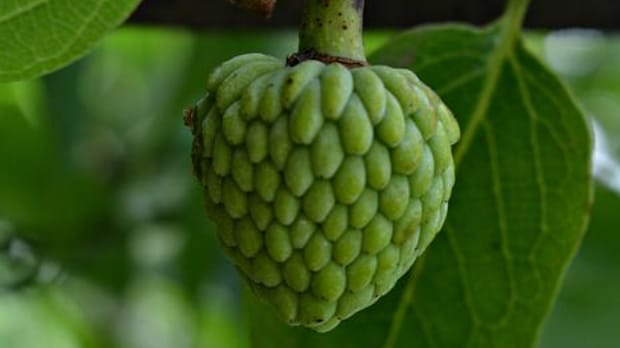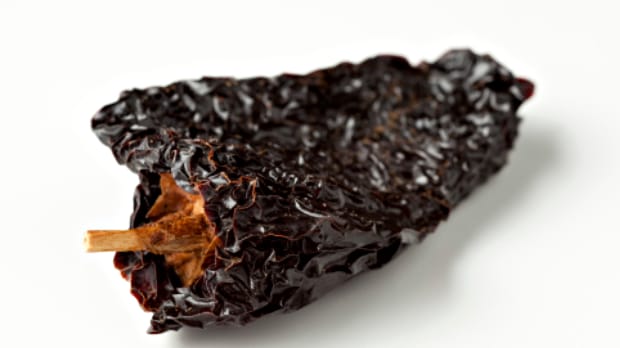What is Cherimoya?
The cherimoya, pronounced cheh·ruh·moy·uh, is a heart-shaped tropical fruit that is also commonly known as a custard apple, due to its appearance and texture. What sets it apart, however, is its unique flavor that combines the sweetness of pineapple, mango, banana, and papaya with a slightly fermented taste that is characteristic of the tropics.
These fruits are available for purchase from November to April, and the largest supply can be found in February and March. When selecting cherimoyas, it is important to look for fruits that are ripe and ready to eat. Such fruits have a dull brownish-green color and give to pressure when gently squeezed. It is recommended to consume the fruit within a day or two of purchase. If the fruit is not yet ripe, it is best to store it at room temperature until it is slightly soft, after which it can be refrigerated, carefully wrapped individually in paper towels, for up to four days.

To enjoy cherimoya, begin by peeling the fruit with a sharp knife and then cutting it into cubes. Any dark black seeds should be discarded. These cubes can then be added to fruit salads or pureed to make a delicious mousse, custard, or pie filling. So why not give this tasty tropical fruit a try? It is sure to add a new and exciting flavor to your favorite dishes.
Nutritional Benefits
If you’re a fan of trying new and exotic fruits, you might want to give the cherimoya a try. This native South American fruit also known as the “custard apple” has a creamy and delicious taste that’s worth indulging in. But did you know that it is also packed with nutritional benefits? Firstly, cherimoya is an excellent source of vitamin C, which is essential for maintaining a healthy immune system. Just one serving of the fruit provides you with more than half of your daily recommended intake of vitamin C. Additionally, cherimoya contains an abundance of antioxidants, which help to protect your body against harmful free radicals that can cause damage to your cells.
Another benefit of cherimoya is its high fiber content, which aids in digestion and can help regulate your blood sugar levels. In addition to fiber, this tropical fruit is also a good source of potassium, a mineral that’s important for maintaining healthy blood pressure levels and preventing heart disease.

But that’s not all! Cherimoya is also packed with vitamin B6, which helps your body produce serotonin, a neurotransmitter that’s essential for regulating your mood and sleep patterns. Plus, it is low in calories and fat, making it a great snack option for those looking to maintain a healthy weight. So, next time you’re at the grocery store, be sure to add cherimoya to your list. Not only is it a tasty treat, but it’s also packed with a variety of nutritional benefits that will help keep you healthy and feeling great.
Types Available
If you’ve never tried a cherimoya, you’re missing out! This exotic fruit is native to South America and has a creamy, sweet taste that’s hard to resist. But did you know that there are actually several different types of this exotic fruit available? Here’s a rundown of some of the most common varieties you might come across.
Fino de Jete: This type of cherimoya is known for its juicy texture and delicate flavor. It’s often said to be one of the sweetest varieties out there.
Booth: The Booth cherimoya is a bit larger than some other types, and has a slightly grainy texture. Its flavor is still sweet, but with a tangy edge.
Pierce: Named after the plant breeder who developed it, the Pierce cherimoya is known for its large size and honeyed flavor.
El Bumpo: This variety of cherimoya has a bumpy, almost spiky skin, but inside, it’s all smooth and creamy goodness. It’s said to have a slightly citrusy taste.
No matter which type you try, they all have something in common: a unique and delicious flavor that’s worth seeking out!
What are the Best Uses?
Are you looking for a unique and delicious fruit to add to your grocery list? Look no further than the cherimoya. This exotic fruit, also known as the “custard apple,” is native to South America and has a sweet and creamy flavor that is sure to please your taste buds. But what are the best uses for it? Here are a few ideas to get you started.
Enjoy it fresh: Cherimoyas can be eaten fresh out of hand like an apple or pear. Simply cut the fruit in half and scoop out the flesh with a spoon.
Make smoothies: Cherimoya adds a creamy texture and sweet flavor to smoothies. Combine it with your favorite fruits and yogurt for a delicious and healthy breakfast or snack.
Blend into ice cream or sorbet: Cherimoya’s creamy texture makes it perfect for making homemade ice cream or sorbet. Try blending it with coconut milk for a tropical twist.
Bake with it: Cherimoya can be used in place of other fruits in baked goods. Try adding it to muffins, cakes, or bread for a unique flavor.
Overall, the unique fruit is versatile and delicious and can be enjoyed in a variety of ways. So the next time you’re at the grocery store, give this exotic fruit a try!
How do You Store Cherimoya?
If you’ve ever tried cherimoya, you know that it’s a delicious and unique fruit that’s definitely worth adding to your collection of favorite foods. But once you’ve purchased some, how do you store it to keep it fresh and enjoyable for as long as possible? Here are a few tips to help you out. First of all, it’s important to note that cherimoyas are best stored at room temperature until they’re fully ripe. This process may take several days, during which time the fruit will soften and the skin may even turn a bit brown. Once the fruit is fully ripe, you can move it to the fridge to help prolong its shelf life for a few more days.
If you’re looking to store an unripe cherimoya for a few days, you can place it in a paper bag with a ripe banana or kiwi. These fruits release ethylene gas, which speeds up the ripening process and helps the unripe fruit become ready to eat more quickly.
Once your cherimoya is ripe and ready to eat, you can slice it open and scoop out the creamy, sweet flesh inside. Enjoy it on its own or use it in recipes for smoothies, desserts, and more. And don’t forget to share the love with your family and friends – this tasty tropical fruit is a treat that everyone deserves to experience!
How to Prepare Cherimoya
Hi there! If you’re looking to explore new and exotic fruits, you’ll want to give the cherimoya a try. This unique fruit hails from South America and has been enjoyed for centuries for its delicious flavor and numerous health benefits. So, how do you prepare a cherimoya? Don’t let its spiky exterior intimidate you. To start, place the fruit on a cutting board and slice off the stem end. Then, cut the fruit in half lengthwise. You’ll now be able to see the fruit’s creamy white flesh, which is filled with large black seeds.
Next, use a spoon to scoop out the flesh, discarding the seeds and any tough skin or membrane. The cherimoya can be eaten as is, or blended into smoothies, used as a topping for yogurt, or even incorporated into baked goods.
And speaking of health benefits, cherimoyas are packed with vitamins, minerals, and antioxidants. They’re a great source of vitamin C, fiber, and potassium, and have been shown to support heart health and boost immunity. So go ahead and give the cherimoya a try – your taste buds and body will thank you!
When is Cherimoya in Season?
Are you a fan of cherimoya? If so, you may be wondering what the best time of year is to indulge in this delectable fruit. As a reminder, cherimoya is a tropical fruit that is native to South America. It has a creamy, custardy texture and a flavor that is often compared to a mix of pineapple, banana, and strawberry.
If you are lucky enough to live in a region where cherimoya is grown, you may be able to find it in local markets throughout the year. However, the peak season for cherimoya tends to be between late fall and early spring.
During this time, cherimoya is more likely to be available in larger quantities and at a lower price point. Plus, the fruit tends to be at its highest quality during these months. So, if you are an enthusiast, keep an eye out for this fruit during the fall, winter, and early spring months. Your taste buds will thank you!
Improve Your Health With Seasonal Eating
What to Serve Cherimoya With?
- Granola
- Coconut Milk
- Yogurt
- Ice Cream
- Honey
- Nuts (Walnuts, Almonds, Cashews)
- Bananas
- Strawberries
- Mango
- Pineapple
What Traditional Cuisines Use Cherimoya?
Cherimoya is a tropical fruit native to South America and is most commonly found in Latin American cuisine. In Peru, it is commonly used in ice cream, juices, and desserts. It is used to make juice, smoothies, and a popular dessert known as “ensalada de Cherimoya” in Ecuador. In Chile, it is used to make mousse and jams. It is common in Colombia, to use it to make ice cream and jam. In Mexico, it is a popular ingredient in smoothies and popsicles.
Tasty Recipes
- Cherimoya Gelato
- Cherimoya Smoothie Bowls
- Bananas Faustos with Cherimoya Salsa
- Cherimoya Tart
- Cherimoya Citrus Sorbet
Key Takeaways
- Wash and rinse the Cherimoya before cutting it open to remove any dirt or debris.
- Cut the Cherimoya in half and scoop out the flesh with a spoon.
- It can be eaten raw or cooked into a variety of dishes such as pies, custards, and sorbets.
- Cherimoya is a sweet fruit and can be enjoyed as a dessert or snack.
- When selecting Cherimoya, look for a fruit that is firm, has a slightly wrinkled skin, and has a slightly sweet aroma.
- This tropical fruit is an excellent source of vitamin C, dietary fiber, and other vitamins and minerals.
- Store Cherimoya at room temperature for up to five days or in the refrigerator for up to two weeks.
References: Nutritional, phytochemical and health benefits of cherimoya (Annona cherimola Mill.): A review | The Health Benefits of Cherimoya (Annona Cherimola) | Phytochemical Composition and Antioxidant Properties of Cherimoya (Annona cherimola Mill.) Fruit | Cherimoya (Annona cherimola Mill.): A Review on Its Nutritional Value and Health Benefits




